Overhead camshaft

Overhead camshaft,[1][2] commonly abbreviated to OHC,[1][2] is a valvetrain configuration which places the camshaft of an internal combustion engine of the reciprocating type within the cylinder heads ('above' the pistons and combustion chambers) and drives the valves or lifters in a more direct manner compared to overhead valves (OHV) and pushrods.
Overview
Compared to OHV pushrod systems with the same number of valves, the reciprocating components of the OHC system are fewer[1] and have a lower overall mass.[1] Though the system that drives the camshafts may be more complex, most engine manufacturers accept that added complexity as a trade-off for better engine performance and greater design flexibility. The fundamental reason for the OHC valvetrain is that it offers an increase in the engine's ability to exchange induction and exhaust gases. (This exchange is sometimes known as 'engine breathing'.[1] ) Another performance advantage is gained as a result of the better optimised port configurations made possible with overhead camshaft designs. With no intrusive pushrods, the overhead camshaft cylinder head design can use straighter ports[1] of more advantageous cross-section and length. The OHC design allows for higher engine speeds than comparable cam-in-block designs, as a result of having lower valvetrain mass. The higher engine speeds thus allowed increases power output for a given torque output.[1]
Disadvantages of the OHC design include the complexity of the camshaft drive, the need to re-time the drive system each time the cylinder head is removed, and the accessibility of tappet adjustment if necessary. In earlier OHC systems, including inter-war Morrises and Wolseleys, oil leaks in the lubrication systems were also an issue.[3]
Single overhead camshaft
Single overhead camshaft (SOHC)[1][4] is a design in which one camshaft is placed within the cylinder head.[1] In an inline engine, this means there is one camshaft in the head, whilst in an engine with more than one cylinder head, such as a V engine or a horizontally-opposed engine (boxer; flat engine) — there are two camshafts: one per cylinder bank.
In the SOHC design, the camshaft operates the valves directly, traditionally via a bucket tappet; or via an intermediary rocker arm.[1][4] SOHC cylinder heads are generally less expensive to manufacture than double overhead camshaft (DOHC) cylinder heads. Timing belt replacement can be easier since there are fewer camshaft drive sprockets that need to be aligned during the replacement procedure.
SOHC designs offer reduced complexity compared to overhead valve designs — when used for multivalve cylinder heads, in which each cylinder has more than two valves. An example of an SOHC design using shim and bucket valve adjustment was the engine installed in the Hillman Imp (four cylinder, eight valve); a small, early 1960s two-door saloon car (sedan) with a rear mounted aluminium-alloy engine based on the Coventry Climax FWMA race engines. Exhaust and inlet manifolds were both on the same side of the engine block (thus not a crossflow cylinder head design). This did, however, offer excellent access to the spark plugs.
In the early 1980s, Toyota and Volkswagen Group[5] also used a directly actuated, SOHC parallel valve configuration with two valves for each cylinder. The Toyota system used hydraulic tappets. The Volkswagen system used bucket tappets with shims for valve clearance adjustment.
Alternative SOHC layouts
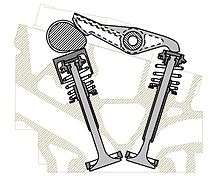
The multivalve Sprint version of the Triumph Slant-4 engine used a system where the camshaft was placed directly over the inlet valves, with the same cams that opened the intake valves directly also opening the exhaust valves through rocker arms.[6]
Honda later used a similar valvetrain system in their motorcycles, using the term "Unicam" for the concept. This system uses one camshaft for each bank of cylinder heads, with the cams operating directly onto the inlet valve(s) and indirectly, through a short rocker arm, onto the exhaust valve(s). This allows a compact, light valvetrain to operate valves in a flat combustion chamber.[7] The Unicam valve train was first used in single cylinder dirt bikes,[8] and has been used on the Honda VFR1200 since 2010.[9]
Dual overhead camshaft
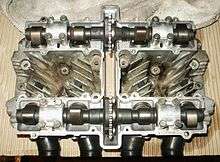
A dual overhead camshaft[1][2][4] (DOHC) valvetrain layout is characterised by two camshafts located within the cylinder head,[4] one operating the intake valves and the other one operating the exhaust valves. This design reduces valvetrain inertia more than is the case with a SOHC engine, since the rocker arms are reduced in size or eliminated. A DOHC design permits a wider angle between intake and exhaust valves than do SOHC engines. This can allow for a less restricted airflow at higher engine speeds. DOHC with a multivalve design also allows for the optimum placement of the spark plug which, in turn, improves combustion efficiency.[4] Engines having more than one bank of cylinders (e.g. V6, V8 — where two cylinder banks meet to form a 'V') with two camshafts in total remain SOHC, unless each cylinder bank has two camshafts; these latter are DOHC,[4] and are often known as 'quad cam'.
Although the term "twin cam" is often used to refer to a DOHC engine, it is imprecise, as it includes designs with two block-mounted camshafts. Examples include the Harley-Davidson Twin Cam engine, Riley car engines from 1926 to the mid 1950s, Triumph motorcycle parallel-twins from the 1930s to the 1980s, and Indian Chief and Scout V-twins from 1920 to the 1950s.
The terms "multivalve" and "DOHC" are separate distinctions;[4] not all multivalve engines are DOHC and not all DOHC engines are multivalve. Examples of DOHC engines with two valves per cylinder include the Alfa Romeo Twin Cam engine and the Jaguar XK6 engine. Most recent DOHC engines are multivalve, with between three and five valves per cylinder.
Triple overhead camshaft
More than two overhead camshafts are not known to have been tried in a production engine. However, MotoCzysz has designed a motorcycle engine with a triple overhead camshaft configuration, with the intake ports descending through the cylinder head to two central intake ports between two outside exhaust camshafts actuating one of two exhaust valves per cylinder each.[10]
Camshaft drive systems
All valve drive systems in four stroke engines must both power the valves and time their opening and closing. The OHC valvetrain system may be driven by the crankshaft using the same methods as an OHV system, but in practice (and depending on the application), lighter weight and maintenance-free methods are more commonly used.
Timing belt
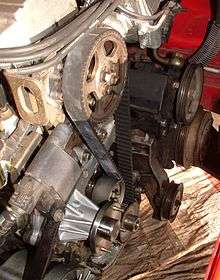
Toothed timing belt made from rubber and kevlar are commonly used to time overhead camshaft automobile engines.[1][4][11] Compared to other camshaft drive systems, timing belts have low design, engineering and production costs, low noise levels, low mass (and consequently low inertia), low space requirements, and no need for lubrication.[12] Timing belt systems are also simpler and more versatile than other drive systems; while it is possible to power engine components such as water pumps or alternators with bevel shaft or gear drive systems, it is simpler to do so with belts.[13]
A disadvantage of timing belts is the need for regular replacement of the belt.[14] Recommended belt life varies between designs; belts made from neoprene for older vehicles might have a recommended life of around 20,000 miles (32,000 km) while newer designs with lower torque loading and made from hydrogenated nitrile butadiene rubber (HNBR) may have a recommended life of 60,000 miles (97,000 km) or more.[15] By 2004, the range for timing belt life for new engine designs was 60,000–100,000 miles (97,000–161,000 km), with some designs having no fixed replacement schedule but with continued use based on visual inspection.[16] Torque loading, vibration, oil, heat and dirt reduce belt life.[14] Timing belts are regularly replaced during engine overhauls.[17]
The first known automotive application of toothed belts to drive overhead camshafts was with Devin-Panhard racing specials built by Bill Devin for the Sports Car Club of America (SCCA) H-modified racing series.[18] Some of these specials were powered by engines built from the crankcases of Panhard flat-twin engines and the cylinders of Norton motorcycles. The overhead camshafts on the Norton cylinders were driven by toothed belts from the Gilmer Belt Company instead of the tower shafts used in the Norton engines. Jimmy Orr won the 1956 SCCA H-modified championship in an overhead camshaft Devin-Panhard.[19]
The first production automobile engine to use a toothed belt to drive an overhead camshaft was made by Hans Glas GmbH for use in their 1004 motor car, introduced in September 1961.[20]
Timing chain
Duplex or single row roller chains have been used to drive overhead camshafts in automobile and motorcycle engines.[1][4][11] By the early 1960s most production automobile overhead camshaft designs used chains to drive the camshaft(s).[21] Timing chain systems are noisier and more expensive than timing belt systems.[22] Timing chains do not usually require replacement at regular intervals,[22] but there have been exceptions, including the timing chain in the Triumph Stag, which has a recommended life of 30,000 miles (48,000 km).[23]
Bevel shaft
The use of a shaft with bevel gears to drive the camshaft was common in overhead camshaft designs before the Second World War. Examples include the Maudslay 25/30[24] built between 1908 and 1911,[25] the Bentley 3 Litre,[26] the 850cc MG Midget and various racing motorcycles including the Velocette 'K' series[27] and the Norton Manx.[28] The MG engine used the armature shaft of the dynamo as the camshaft drive, which was an economical use of parts but made servicing difficult.
All Ducati single-cylinder OHC motorcycle engines used a bevel shaft system to drive the camshaft.[29] Some of their V-Twins also used bevel camshaft drive. The Kawasaki W650 (1999-2007) and its successor the Kawasaki W800 (2011-2016) [30] use a bevel shaft drive system for its overhead camshaft. The W800 is at this moment the only production engine to use a bevel gear and the "Final Edition", released at the end of 2016, will mark the end of this distribution system [31]
Gear train
Trains of timing gears are commonly used in diesel overhead camshaft engines used in heavy trucks.[32] They are less commonly used in overhead camshaft engines in light trucks or automobiles.[1]
Cranks and rods
British engineer J. G. Parry-Thomas developed a camshaft drive using three sets of cranks and rods in parallel.[33] Parry-Thomas used this drive system in the Leyland Eight.[34] W. O. Bentley used a similar system, called the "three-throw drive", in his six-cylinder engines, the 6½ Litre and the 8 Litre.[34][35]
The overhead camshaft of the NSU Prinz used a two-rod system with counterweights at both ends of the drive system.[36] NSU began using the system in the early 1950s and continued to use it in the Prinz 4 and Prinz Sport in the mid-1960s,[37] although the NSU 1000 used a chain-driven system instead.[38]
Variable valve timing
In conjunction with multiple valves (three, four or five) per cylinder,[1] many OHC engines today employ variable valve timing[1] to improve efficiency and power.[1]
History
Early use
Among the first cars to utilize engines with single overhead camshafts were the Maudslay designed by Alexander Craig and introduced in 1902[39] and the Marr Auto Car designed by Michigan native Walter Lorenzo Marr in 1903.[40][41] The first DOHC car was the 1912 Peugeot which won the French Grand Prix at Dieppe that year. This car was powered by a straight-4 engine designed by Ernest Henry under the guidance of the technically knowledgeable racing drivers Paul Zuccarelli and Georges Boillot. Boillot, who drove the winning car that year, won the French Grand Prix for Peugeot again in 1913 but was beaten in 1914 by the SOHC Mercedes of Christian Lautenschlager.
Aircraft engines

Both the Allies and the Central Powers quickly adapted the overhead camshaft engine designs that had been used in racing cars just before the First World War to their liquid-cooled aircraft engines. The 1914 Mercedes SOHC racing car engine became the starting point for both Mercedes' six-cylinder aero-engine family, and the Rolls-Royce Eagle V12, whose cylinder heads were reverse-engineered from a Mercedes racing car left behind in England at the beginning of the war. The Mercedes designs culminated in the Mercedes D.III. Other SOHC designs included the fully enclosed-drivetrain Hispano-Suiza 8 — a V8 engine designed by Marc Birkigt and the late-war Liberty L-12 on the Allied side; and the powerful BMW IIIa on the side of the Central Powers.
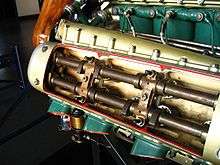
The aircraft engines listed above all used bevel shaft camshaft drives. Large aircraft engines, particularly air-cooled, saw considerable thermal expansion over the height of the cylinder block. This made pushrod engines difficult to arrange. As well as the other advantages of direct valve actuation by an overhead camshaft, a bevel shaft with a sliding spline was the easiest way to allow for this expansion. These bevel shafts were usually in an external tube outside the block, and were known as "tower shafts".[42]
By the end of the war the DOHC Napier Lion had entered service with the Allies.
Inter-war use
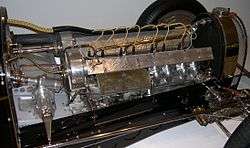
Among the early pioneers of DOHC were Isotta Fraschini's Giustino Cattaneo, Austro-Daimler's Ferdinand Porsche, Stephen Tomczak (in the Prinz Heinrich) (in 1919); Sunbeam built small numbers of racing models between 1921 and 1923 and introduced one of the world's first production DOHC auto engines in 1924 — the Sunbeam 3 litre Super Sports, an example of which came second at Le Mans in 1925.[43] The first DOHC engines were either two- or four-valve per cylinder racing car designs from companies like Fiat (1912), Peugeot Grand Prix (1912, four-valve), Alfa Romeo Grand Prix (1914, four-valve)[44] and 6C (1928), Maserati Tipo 26 (1926), Bugatti Type 51 (1931). and three years later, Harry A. Miller and Fred Offenhauser inaugurated the line of 4.1 litre DOHC Offenhauser inline-4 American auto racing engines, which began to dominate American open-wheel auto racing through much of the 20th century.
American luxury automaker Duesenberg was an early proponent of overhead camshaft engines with their SOHC straight eight Model A,[45] produced from 1921-1927. Duesenberg also produced successful OHC race car engines in the 1920s. The 1928-1937 Duesenberg Model J featured a 420 cu in (6.9 L) DOHC straight eight engine producing 265 horsepower.
Post-war use

Crosley, an American manufacturer of small, low-priced cars, used a 44 cu in (724 cc) 4-cylinder SOHC engine following World War II.[46] The original version of the engine was developed during the war by Lloyd Taylor and built under license by Crosley for military applications, including as a powerplant for generators.[47] This design was made of steel stampings, copper-brazed together to form a strong and light block assembly. It was known as the CoBra engine ("COpper BRAzed") and generated 26.5 hp (19.8 kW) in automotive form. The overhead camshaft was driven by a tower shaft and gears. [48][49] The bi-metallic construction of the CoBra engine and the salt-based antifreeze then in common use led to electrolysis and corrosion problems. A more traditional design with a cast iron block assembly (CIBA) was introduced in 1949; the components and dimensions were otherwise the same as the CoBra.[50] Used in Crosley's Hot Shot sports car, this small OHC engine won the first race at Sebring in 1950.[48] The Crosley OHC was popular in H-modified racing for its high-RPM performance. After Crosley ceased automotive production, the engine was produced by several other companies for many years, its last application being the Bearcat 55 outboard motor manufactured by Fisher Pierce, builders of the Boston Whaler boats.[51]
When DOHC technology was introduced in mainstream vehicles, it was common for it to be heavily advertised. While used at first in limited production and sports cars such as the 1925 Sunbeam 3 litre, Alfa Romeo is one of the twin cam's greatest proponents. 6C Sport, the first Alfa Romeo road car using a DOHC engine, was introduced in 1928. Ever since this, DOHC has been a trademark of most Alfa Romeo engines (some Alfa V6 engines are SOHC, not DOHC. Most Alfasud boxer engines were also SOHC).[44][52] The Jaguar XK6 engine with chain-driven DOHC was displayed in the Jaguar XK120 at the London Motor Show in 1948, and used across the entire Jaguar range through the late 1940s, 1950 and 1960s.
Fiat was one of the first car companies to use belt-driven DOHC engines in the mid-1960s.[53]
See also
References
- 1 2 3 4 5 6 7 8 9 10 11 12 13 14 15 16 17 Hillier, V.A.W. (2012) [First published 1966]. "2". Fundamentals of Motor Vehicle Technology (Academic text-book). Book 1. In association with: (IMI) (6th ed.). Nelson Thornes Ltd. ISBN 9781408515181.
- 1 2 3 Stoakes, Graham; Sykes, Eric; Whittaker, Catherine (2011). "3". Principles of Light Vehicle maintenance & repair. Heinmann Work-Based Learning. Babcock International Group and Graham Stoakes. pp. 208–209. ISBN 9780435048167.
- ↑ Boddy, William (January 1964). Boddy, William, ed. "Random Thoughts About O.H.C.". Motor Sport. London, UK: Teesdale Publishing. XL (1): 15–18.
- 1 2 3 4 5 6 7 8 9 Tan, Paul (22 June 2005). "SOHC vs DOHC Valvetrains: A Comparison". PaulTan.org. Driven Communications Sdn Bhd. Retrieved 29 August 2012.
- ↑ ETKA
- ↑ Heseltine, Richard (June 2010). Roebuck, Nigel, ed. "Triumph Dolomite Sprint". Motor Sport. London, UK. 86 (6): 122. ISSN 0027-2019. Retrieved 29 March 2015.
- ↑ Lewis, Jimmy (November 2001). Edwards, David, ed. "New for '02: Honda CR250R CRF450R". Cycle World. Hachette-Filipacchi Magazines. 40 (11): 62. ISSN 0011-4286. Retrieved 2 January 2015.
- ↑ "How It Works: Honda Unicam® Engines". 23 January 2013. Archived from the original on 22 February 2014. Retrieved 2 January 2015.
- ↑ Cantin, Marc (19 October 2009). "2010 Honda VFR1200A First Ride". Moto123.com. Archived from the original on 2 January 2015. Retrieved 2 January 2015.
- ↑ "Introducing MotoCzysz Z-Line 4 Engine". MotoCzysz. MotoCzysz.com. 2006-08-25. Retrieved 29 August 2012.
- 1 2 "Dan's motorcycle 'Cam Drives'". dansmc.com. Retrieved 29 August 2012.
- ↑ Decker, John (June 1993). Oldham, Joe, ed. "Saturday Mechanic: Replacing Your Timing Belt". Popular Mechanics. New York, NY US: Hearst. 170 (6): 93. ISSN 0032-4558. Retrieved 1 March 2015.
- ↑ Decker 1993, pp. 93–94.
- 1 2 Decker 1993, p. 94.
- ↑ Decker 1993, pp. 94–95.
- ↑ Dorries, Elisabeth H. (2005). TechOne: Automotive Engine Repair. Clifton Park, NY US: Thompson Delmar Learning. p. 250. ISBN 1-4018-5941-0. LCCN 2004057974. Retrieved 1 March 2015.
- ↑ Dorries 2005, p. 250.
- ↑ Pace, Harold W.; Brinker, Mark R. (2004). Vintage American Road Racing Cars 1950-1969. St. Paul MN US: MotorBooks International. p. 62. ISBN 0-7603-1783-6. Retrieved 27 February 2015.
- ↑ Pace & Brinker 2004, p. 62.
- ↑ Norbye, Jan P. (1984). "Expanding on Excellence: The 5-Series and 3-Series". BMW - Bavaria's Driving Machines. Skokie, IL: Publications International. p. 191. ISBN 0-517-42464-9.
- ↑ Boddy 1964, p. 17.
- 1 2 Dorries 2005, p. 253.
- ↑ McKay, Malcolm (February 1996). Coucher, Robert, ed. "First & Last Stag triumphant". Thoroughbred & Classic Cars. London, UK: IPC Magazines. 23 (5): 18.
- ↑ Boddy, William (August 1972). Boddy, William, ed. "An Edwardian Overhead-Camshaft 25/30 Maudslay". Motor Sport. London, UK: Teesdale Publishing. XLVIII (8): 909. Archived from the original on 6 February 2015. Retrieved 6 February 2015.
- ↑ Culshaw, David; Horrobin, Peter (2013) [1974]. "Maudslay". The Complete Catalogue of British Cars 1895 - 1975 (e-book ed.). Poundbury, Dorchester, UK: Veloce Publishing. p. 210. ISBN 978-1-845845-83-4.
- ↑ Norbye, Jan P. (1981). The complete handbook of automotive power trains. Tab Books. p. 318. ISBN 0-8306-2069-9. LCCN 79026958. Retrieved 7 January 2015.
- ↑ Cameron, Kevin (March 2004). "TDC: Little things". Cycle World. 43 (3): 14. ISSN 0011-4286. Retrieved 7 January 2015.
- ↑ Wilson, Hugo (1995). "The A-Z of Motorcycles". The Encyclopedia of the Motorcycle. London, UK: Dorling Kindersley. p. 144. ISBN 0-7513-0206-6.
- ↑ Walker, Mick (2003) [1991]. "4 Engine". Ducati Singles Restoration. St. Paul, MN US: Motorbooks International. p. 48. ISBN 0-7603-1734-8. Retrieved 4 January 2015.
- ↑ "2015 W800". Kawasaki Motors Europe. 2014.
- ↑ Ash, Kevin (26 October 2011). "Kawasaki W800 review". The Telegraph. Archived from the original on 21 June 2013.
- ↑ Bennett, Sean. Modern Diesel Technology: Diesel Engines. Stamford, CT US: Cengage Learning. pp. 88–89, 362. ISBN 978-1-285-44296-9. Retrieved 4 January 2015.
In most commercial diesels, OHCs are gear-driven.
- ↑ References:
- A US patent 1495620 A, John Godfrey Parry Thomas, "Internal Combustion Engine", issued 1924-05-27
- U.S. Patent 1,495,620
- 1 2 Boddy, William (March 1974). Boddy, William, ed. "How Did The Leyland Eight Rate?". Motor Sport. L (3): 230. Retrieved 3 January 2015.
- ↑ Brooks, Philip C. (2009). Carpenter, Rhonda; Iwalani, Kahikina, eds. "The Mighty Sixes". The International Club for Rolls-Royce & Bentley Owners Desk Diary 2010. Tampa, FL USA: Faircount: 27, 32.
- ↑ Boddy 1964, p. 16.
- ↑ Boddy 1964, pp. 17, 18.
- ↑ Boddy 1964, p. 18.
- ↑ References:
- Georgano, G. N. (1982) [1968]. "Maudslay". In Georgano, G. N. The New Encyclopedia of Motorcars 1885 to the Present (Third ed.). New York: E. P. Dutton. p. 407. ISBN 0525932542. LCCN 81-71857.
- Culshaw & Horrobin 2013, p. 210
- Boddy 1972, p. 906
- ↑ Marr Auto Car Company
- ↑ Kimes, Beverly Rae (2007). Walter L Marr: Buick's Amazing Engineer. Racemaker Press. p. 40. ISBN 0976668343.
- ↑ Thorpe, Leslie Aaron (1936). A text book on aviation: the new cadet system of ground school training. 3. Aviation Press. pp. 14–15. Retrieved 27 February 2015.
The overhead camshafts are driven by bevel gears and vertical shafts known as tower shafts.
- ↑ Georgano, G.N. Cars: Early and Vintage, 1886-1930. (London: Grange-Universal, 1985).
- 1 2 Kevin Clemens (February 2009). "An Echo of the Past — the history and evolution of twin-cam engines". EuropeanCarWeb.com. European Car Magazine, Source Interlink Media. Archived from the original on 3 March 2012. Retrieved 29 August 2012.
- ↑ Mueller, Mike (2006). "Chapter 6 - Chariot of the Gods Duesenberg Straight Eight". American Horsepower 100 Years of Great Car Engines. St. Paul, MN USA: Motorbooks. p. 51. ISBN 978-0-7603-2327-4. LCCN 2006017040. Retrieved 2015-02-02.
- ↑ Simanaitis, Dennis (January 1994). Bryant, Thos L., ed. "Tech Tidbits". Road & Track. Newport Beach, CA US: Hachette Filipacchi Magazines. 45 (6): 121. ISSN 0035-7189.
- ↑ Bollman, Jim. "Crosley Engine Family Tree - Taylor Years".
- 1 2 Simanaitis 1994, p. 121.
- ↑ Bollman, Jim. "Crosley Engine Family Tree - CoBra Years".
- ↑ Bollman, Jim. "Crosley Engine Family Tree - CIBA Years".
- ↑ (Bollman, Jim. "Crosley Engine Family Tree - Big Block Years".
- ↑ "Technical- Boxer History". Alfisti.co.uk. Archived from the original on 29 March 2013.
- ↑ "Old Fiat ad with Aurelio Lampredi". Retrieved 31 January 2015.